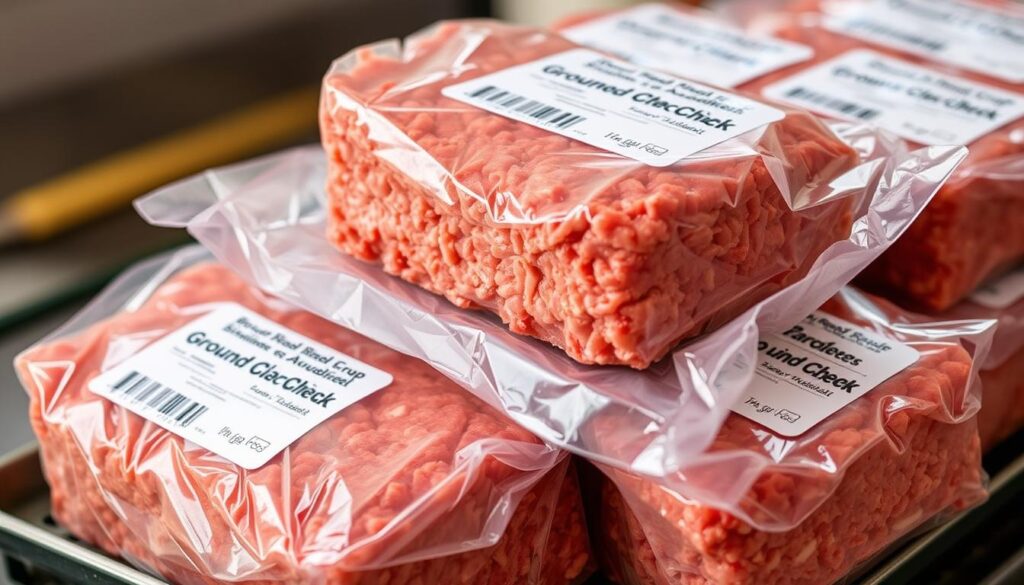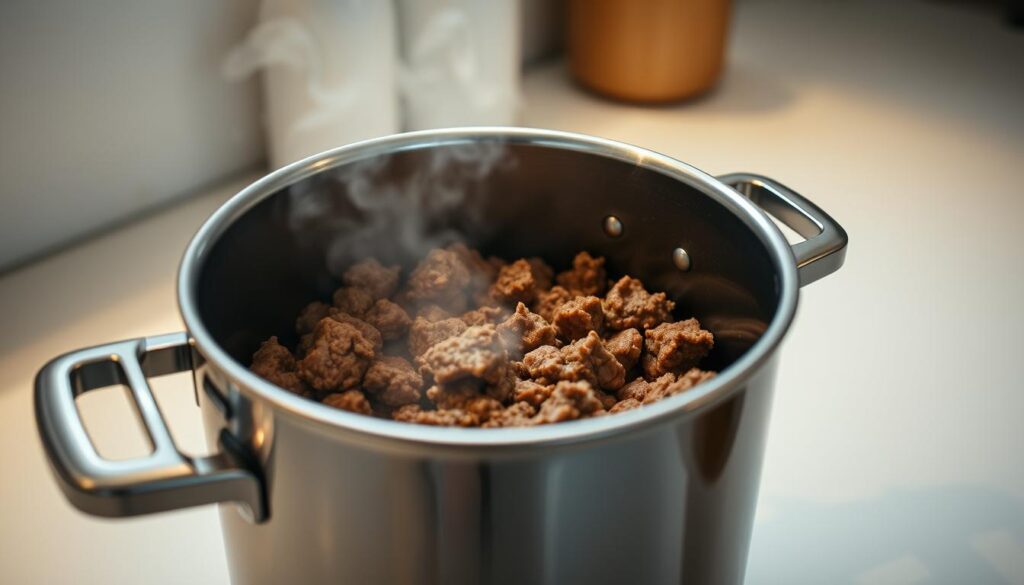Delicious Ground Chuck Meat: A Versatile Ingredient
You know the satisfaction of biting into a juicy, flavorful burger. The secret often lies in the type of ground beef used. Ground chuck meat stands out for its rich flavor and optimal fat content, making it a favorite among chefs and home cooks alike.
When it comes to cooking, the balance of fat and flavor in ground chuck creates a truly desirable experience. Whether you’re making burgers, meatloaf, or other dishes, this versatile ingredient is sure to impress. Its popularity in American cuisine stems from its ability to deliver consistently delicious results.
Key Takeaways
- Ground chuck meat is preferred for its optimal balance of flavor and fat content.
- It’s a versatile ingredient used in various dishes, from burgers to meatloaf.
- The specific fat-to-lean ratio in ground chuck enhances the cooking experience.
- Ground chuck is often recommended for making juicy, flavorful hamburgers.
- Its rich flavor makes it a staple in many American recipes.
What Is Ground Chuck Meat?
The term “ground chuck” refers to a specific cut of beef that is known for its balanced lean-to-fat ratio. Ground chuck is derived from the chuck section of the beef, which comes from the shoulder area. This cut is favored for its rich flavor and suitable fat content.
Origin and Cut Location
Ground chuck originates from the chuck primal cut, which is taken from the shoulder and neck area of the cow. This region is known for its rich flavor due to the marbling of fat within the meat. The chuck cut is then ground to create ground chuck, which is a popular choice for various recipes due to its taste and texture.
Fat Content and Composition
Ground chuck typically features an 80/20 lean-to-fat ratio, meaning it contains 80% lean meat and 20% fat. This specific fat content is crucial for maintaining juiciness and flavor during cooking. The fat in ground chuck is distributed throughout the meat, creating a consistent cooking experience. The composition includes both intramuscular fat (marbling) and intermuscular fat, contributing to its rich flavor profile.
To illustrate the benefits of the 80/20 ratio, consider the following comparison:
| Ground Beef Type | Lean-to-Fat Ratio | Characteristics |
|---|---|---|
| Ground Chuck | 80/20 | Juicy, flavorful, ideal for burgers and meatballs |
| Ground Round | 85/15 or 90/10 | Leaner, less juicy, suitable for health-conscious recipes |
| Regular Ground Beef | 70/30 | Higher fat content, often used for specific cooking applications |
As shown in the table, the 80/20 ratio of ground chuck provides a balance between leanness and fat content, making it a versatile choice for various cooking needs. The fat content not only affects the texture and moisture of the cooked product but also enhances the overall flavor.
Ground Chuck vs. Other Ground Beef Types
The world of ground beef is diverse, with various types offering unique characteristics that can make or break a dish. As you navigate the options, understanding the differences between ground chuck and other types of ground beef can help you choose the best one for your recipes.
Ground Chuck (80/20)
Ground chuck is known for its 80/20 lean-to-fat ratio, making it a popular choice for burgers and meatballs. The higher fat content contributes to juicier, more flavorful dishes.

Ground Round (85-89% lean)
Ground round is leaner than ground chuck, typically containing 85-89% lean meat. It’s a good option for those looking to reduce fat in their dishes without sacrificing too much flavor.
Ground Sirloin (90-95% lean)
Ground sirloin is one of the leanest types of ground beef, with a lean-to-fat ratio of 90-95%. It’s ideal for health-conscious cooks or recipes where a leaner beef is preferred.
Regular Ground Beef (70-77% lean)
Regular ground beef, also known as ground hamburger, typically contains 70-77% lean meat, making it the highest in fat among the common types. It’s often made from various trimmings from different parts of the cow, which can result in inconsistent cooking results. However, its higher fat content makes it more affordable and can provide a rich flavor when cooked correctly.
When using regular ground beef, it’s essential to consider the cooking method. Draining excess fat during or after cooking can help mitigate greasiness. This type of ground beef is best suited for dishes like tacos or spaghetti Bolognese, where the flavor can shine and excess fat can be drained.
The Flavor Profile of Ground Chuck Meat
The distinct flavor of ground chuck meat is attributed to its higher fat content, making it a favorite among many culinary enthusiasts. Ground chuck, with its characteristic 80/20 lean-to-fat ratio, offers a richer taste experience compared to leaner ground beef options.
Rich Beefy Taste
Ground chuck’s rich beefy taste is a result of its composition. The 20% fat content plays a crucial role in developing its characteristic flavor during cooking. You’ll appreciate how the fat acts as a carrier for both fat-soluble flavor compounds and aromas, enhancing the overall taste.
How Fat Content Affects Flavor
The fat in ground chuck significantly impacts its flavor profile. During cooking, fat contributes to the Maillard reaction, creating complex flavors associated with properly cooked ground chuck. You’ll understand why reducing fat content below certain levels can impact the flavor profile of the final dish. Moreover, the type of fat in ground chuck differs from that in other cuts, contributing to its distinctive flavor characteristics.
Balancing fat content is key to optimal flavor while managing health considerations. By understanding the role of fat in flavor development, you can make informed decisions about using ground chuck in your recipes.
Best Culinary Uses for Ground Chuck
Ground chuck is a versatile ingredient that can elevate various dishes, from classic comfort food to international cuisine. Its rich flavor and appropriate fat content make it suitable for a wide range of recipes.
Perfect for Juicy Hamburgers
One of the most popular uses for ground chuck is in making juicy hamburgers. The fat content in ground chuck, typically around 20%, ensures that burgers remain moist and flavorful, even when cooked to well-done. This makes it a favorite among burger enthusiasts who value both taste and texture.
Ideal for Meatballs and Meatloaf
Ground chuck is also an excellent choice for meatballs and meatloaf. Its composition allows for the creation of tender, flavorful meatballs that hold their shape well, while the fat content contributes to a moist and savory meatloaf. The beefy flavor of ground chuck enhances these dishes, making them more satisfying.
Other Popular Dishes
Beyond burgers and meatballs, ground chuck excels in various other dishes. It’s a key ingredient in chili con carne, where its flavor depth and texture are defining characteristics. Ground chuck also performs well in pasta sauces like Bolognese, adding a silky texture. It’s versatile enough for stuffed dishes like peppers or cabbage rolls, maintaining moisture during cooking. Additionally, ground chuck can be used in breakfast applications, such as homemade sausage blends or biscuits and gravy.
| Dish | Characteristics | Benefits of Using Ground Chuck |
|---|---|---|
| Hamburgers | Juicy, flavorful | Moisture retention due to fat content |
| Meatballs/Meatloaf | Tender, savory | Enhanced flavor and moisture |
| Chili con Carne | Flavorful, textured | Depth of flavor and texture |
| Pasta Sauces | Silky texture | Fat content enhances sauce texture |
Cooking Tips for Ground Chuck Meat

Mastering the art of cooking ground chuck can elevate your dishes from good to great. To achieve this, you need to focus on two critical aspects: cooking to a safe temperature and preserving the meat’s natural juiciness.
Temperature Guidelines for Safety
Cooking ground beef to the right temperature is crucial for food safety. Ground beef must be cooked to at least 72 °C (160 °F) to kill any harmful bacteria that may be present. It’s also important to note that the color of cooked meat is not always a reliable indicator of its safety, as beef can brown before reaching the required temperature.
Always use a food thermometer to check the internal temperature of your ground chuck, especially when cooking burgers or meatballs.
Techniques to Preserve Juiciness
To keep your ground chuck dishes juicy, several techniques can be employed. First, handle the meat minimally before cooking to prevent it from becoming dense. Starting with room temperature ground chuck can also lead to more even cooking. After cooking, allow the meat to rest, enabling the juices to redistribute. You can also add ingredients like breadcrumbs or vegetables to help retain moisture.
The choice of cooking method—grilling, pan-frying, or baking—can significantly impact the final texture of your dish. Experiment with different techniques to find what works best for your recipes.
Nutritional Comparison of Ground Beef Types
The nutritional comparison of different ground beef types, including ground chuck, can help you make healthier decisions. Ground beef is a staple in many diets, and understanding its nutritional profile is essential for balanced eating.
Calories and Fat Content
When comparing ground beef types, calories and fat content are crucial factors. Ground chuck typically contains around 80% lean meat and 20% fat. This fat content contributes to its higher calorie count compared to leaner options.
| Ground Beef Type | Lean Percentage | Calories per 3 oz serving | Fat Content (g) |
|---|---|---|---|
| Ground Chuck | 80% | 225 | 15 |
| Lean Ground Beef | 90% | 180 | 8 |
| Regular Ground Beef | 70% | 250 | 20 |
Protein and Other Nutrients
Beyond its fat content, ground chuck is a rich source of high-quality protein and essential micronutrients like B vitamins, zinc, and iron. The protein in ground beef is considered complete, meaning it contains all nine essential amino acids your body needs.
Key Nutrients in Ground Chuck:
- Protein: 22 grams per 3 oz serving
- Iron: 15% of the Daily Value (DV) per 3 oz serving
- Zinc: 25% of the DV per 3 oz serving
- Vitamin B12: 60% of the DV per 3 oz serving
Conclusion: Choosing the Right Ground Beef for Your Needs
As you’ve explored the different types of ground beef, you’re now equipped to make the best choice for your culinary needs. Selecting the right ground beef involves balancing considerations of flavor, fat content, cooking method, and dietary preferences.
The key advantages of ground chuck include its superior flavor and excellent moisture retention, making it ideal for dishes like juicy hamburgers and meatballs. However, its higher calorie content and greater shrinkage during cooking compared to leaner options like ground sirloin or ground round should be considered.
For common dishes, you can choose the most suitable ground beef type: ground chuck for hamburgers, ground sirloin for a leaner option, or a custom blend for a balance of flavor and fat content. When choosing between ground beef types, consider your budget and culinary goals to maximize value.
To maintain the quality of ground chuck, follow proper purchasing, storing, and freezing techniques. By making informed choices based on your specific needs, you can elevate your cooking and enjoy the versatility of ground beef in various recipes.




